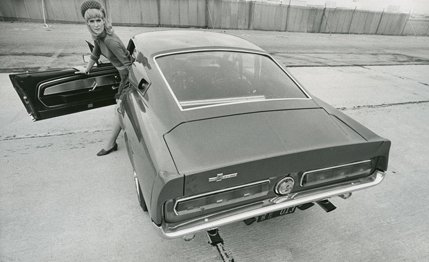So we braced ourselves when we stuck our editorial foot into the first production GT 500. And when it only turned 15.0 at 95, we were a bit disappointed. That’s only 2/10ths of a second quicker than the Mustang 390 automatic (C/D, November ’65) and last year’s GT 350H automatic (C/D, May ’66), and not quite as fast as the original GT 350 4-speed (C/D, May ’65). But then we thought back on the earlier GT 350s and realized that what the old Shelby Mustang does with difficulty, the GT 500 does easily.
The GT 500 is an adult sports car. Shelby’s Mustangs have come a long way in three years–from adolescence to maturity. The ’65 GT 350 was a hot-rodder’s idea of a sports car–a rough-riding bronco that was as exciting to drive as a Maserati 300S, and about as marketable a proposition. The traction bars clanked, the side exhausts were deafening, the clutch was better than an advanced Charles Atlas program, and when the ratcheting-type limited-slip differential unlocked, it sounded like the rear axle had cracked in half. It rode like a Conestoga wagon and steered like a 1936 Reo chain-drive, solid-tire coal truck … and we loved it. It was a man’s car in a world of increasingly effeminate ladies’ carriages. You drove it brutally and it reacted brutally. Every minute at speed was like the chariot-racing scene in “Ben Hur.”
Unfortunately for Shelby, the market for a car as hairy as this was limited. One state’s motor vehicle bureau complained that the brakes, although virtually fade-proof, required too much pedal pressure. Apparently, the inspectors’ leg muscles had atrophied from years of dainty stabs at over-boosted power brakes.
|
|
For 1966, Shelby toned the GT 350 down from a wild mustang to a merely high-strung thoroughbred. It was barely tame enough for the Hertz Corporation, which bought 1000 of them and put them into service as the hottest rent-a-cars the business has ever seen.
The GT 350 still wasn’t acceptable to a large enough body of potential buyers, so, in 1967, an abrupt change in policy has transformed the Shelby Mustang. The $1000-or-so above the price of a comparable Mustang that used to go into expensive, unseen mechanical improvements is now lavished instead on exterior styling changes. The back lot at Shelby American’s remanufacturing plant is littered with stock Mustang front and rear sheet metal, and engine and trunk lids. In their stead go fiberglass panels stylized by Ford’s Chuck McHose, working in close co-operation with Shelby American.
The new nose piece arches tautly forward, forming a deep cowling for the headlights (changed from duals to quads, with the high-beams centered in the grille, driving-lamp style). The hood features an air scoop even larger than last year’s, now divided by an air-splitter, and it’s still functional. At the rear, the new trunk lid and tail piece combine to form a racy-looking aerodynamic spoiler lip. No one would say for sure if high-speed tests had proved the efficiency of this styling gimmick or not—but it looks right. Finally, the side louvres have been replaced by scoops—big hairy scoops that poke out into the airstream beyond the boundary layer. Actually, these are to let the air out; stale interior air exits through the inconspicuous slot behind the scoop. The forward facing scoop leads to a narrow venturi area that helps draw air out the rear slot. That light behind the scoop flashes when the turn signals are on and glows steadily when the brakes are on. Another pair of funnel scoops are installed at the rear of the sculptured side panel—this time to blow air at the rear brake drums. A pair of giant taillights running almost the full width of the Kamm-inspired tail completes the Shelby look. As a whole, the Shelby Mustangs make the regular Mustangs look sick.
View Photos
View Photos


Leave a Reply